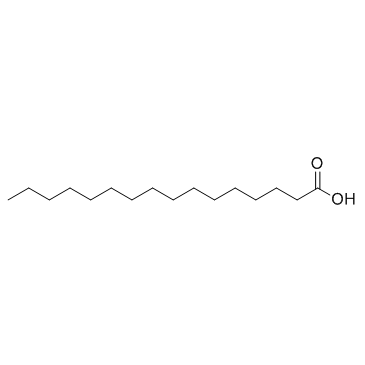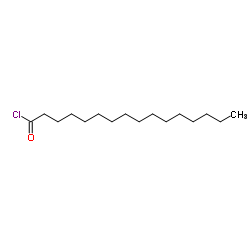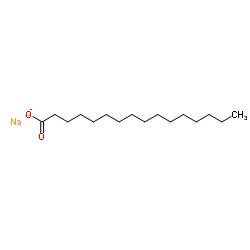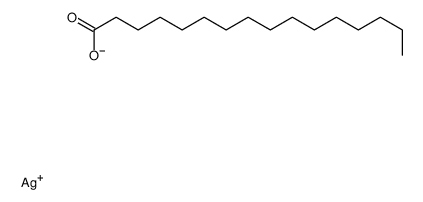Palmitic anhydride

Palmitic anhydride structure
|
Common Name | Palmitic anhydride | ||
|---|---|---|---|---|
| CAS Number | 623-65-4 | Molecular Weight | 494.83300 | |
| Density | 0.887 g/cm3 | Boiling Point | 488.6ºC at 760 mmHg | |
| Molecular Formula | C32H62O3 | Melting Point | 61-64 °C(lit.) | |
| MSDS | Chinese USA | Flash Point | N/A | |
| Symbol |

GHS05 |
Signal Word | Danger | |
Use of Palmitic anhydridePalmitic anhydride is a biochemical reagent that can be used as a biological material or organic compound for life science related research. |
| Name | Palmitic anhydride |
|---|---|
| Synonym | More Synonyms |
| Description | Palmitic anhydride is a biochemical reagent that can be used as a biological material or organic compound for life science related research. |
|---|---|
| Related Catalog |
| Density | 0.887 g/cm3 |
|---|---|
| Boiling Point | 488.6ºC at 760 mmHg |
| Melting Point | 61-64 °C(lit.) |
| Molecular Formula | C32H62O3 |
| Molecular Weight | 494.83300 |
| Exact Mass | 494.47000 |
| PSA | 43.37000 |
| LogP | 11.01880 |
| Index of Refraction | 1.458 |
| Storage condition | 2-8°C |
| Symbol |

GHS05 |
|---|---|
| Signal Word | Danger |
| Hazard Statements | H314 |
| Precautionary Statements | P280-P305 + P351 + P338-P310 |
| Personal Protective Equipment | Eyeshields;Faceshields;full-face particle respirator type N100 (US);Gloves;respirator cartridge type N100 (US);type P1 (EN143) respirator filter;type P3 (EN 143) respirator cartridges |
| Hazard Codes | C: Corrosive; |
| Risk Phrases | R34 |
| Safety Phrases | S26-S36/37/39-S45-S25 |
| RIDADR | UN 3261 8/PG 2 |
| WGK Germany | 3 |
| Hazard Class | 8.0 |
| HS Code | 2915900090 |
|
~99% 
Palmitic anhydride CAS#:623-65-4 |
| Literature: Kita, Yasuyuki; Akai, Shuji; Ajimura, Naomi; Yoshigi, Mayumi; Tsugoshi, Teruhisa; et al. Journal of Organic Chemistry, 1986 , vol. 51, # 22 p. 4150 - 4158 |
|
~94% 
Palmitic anhydride CAS#:623-65-4 |
| Literature: Hu, Yulai; Wang, Jin-Xian; Li, Shihua Synthetic Communications, 1997 , vol. 27, # 2 p. 243 - 248 |
|
~42% 
Palmitic anhydride CAS#:623-65-4 |
| Literature: Plusquellec, Daniel; Roulleau, Fabienne; Lefeuvre, Martine; Brown, Eric Tetrahedron, 1988 , vol. 44, # 9 p. 2471 - 2476 |
|
~% 
Palmitic anhydride CAS#:623-65-4 |
| Literature: Zhurnal Obshchei Khimii, , vol. 7, p. 2938 Chem. Zentralbl., , vol. 110, # I p. 1747 |
|
~% 
Palmitic anhydride CAS#:623-65-4 |
| Literature: Zhurnal Russkago Fiziko-Khimicheskago Obshchestva, , vol. 31, p. 103 Chem. Zentralbl., , vol. 70, # I p. 1070 |
|
~% 
Palmitic anhydride CAS#:623-65-4 |
| Literature: Chemische Berichte, , vol. 9, p. 1932 |
|
~% 
Palmitic anhydride CAS#:623-65-4 |
| Literature: Journal of the Chemical Society, , p. 1460 |
| HS Code | 2915900090 |
|---|---|
| Summary | 2915900090 other saturated acyclic monocarboxylic acids and their anhydrides, halides, peroxides and peroxyacids; their halogenated, sulphonated, nitrated or nitrosated derivatives VAT:17.0% Tax rebate rate:9.0% Supervision conditions:AB(certificate of inspection for goods inward,certificate of inspection for goods outward) MFN tariff:5.5% General tariff:30.0% |
|
Assessment of acylation routes and structural characterisation by liquid chromatography/tandem mass spectrometry of semi-synthetic acyl ester analogues of lipophilic marine toxins.
Rapid Commun. Mass Spectrom. 28(23) , 2605-16, (2014) Esterification is one of the most important metabolic routes of lipophilic marine toxins in shellfish. In this work we assessed several chemical acylation reactions aimed at obtaining acyl ester analo... |
|
|
Novel polymer micelles prepared from chitosan grafted hydrophobic palmitoyl groups for drug delivery.
Mol. Pharm. 3(2) , 152-60, (2006) Chitosan-based polymer micelles have a splendid outlook for drug delivery owing to the interesting properties, abundance, and low cost of chitosan. A new method of preparation of water-soluble N-palmi... |
|
|
Discovery of fatty acid ester metabolites of spirolide toxins in mussels from Norway using liquid chromatography/tandem mass spectrometry.
Rapid Commun. Mass Spectrom. 20(10) , 1531-7, (2006) Cultured mussels sampled in the spring of 2002 and 2003 from Skjer, a location in the Sognefjord, Norway, tested positive in the mouse bioassay for lipophilic toxins. In a previous report, it was esta... |
| hexadecanoyl hexadecanoate |
| MFCD00008992 |
| EINECS 210-805-0 |




